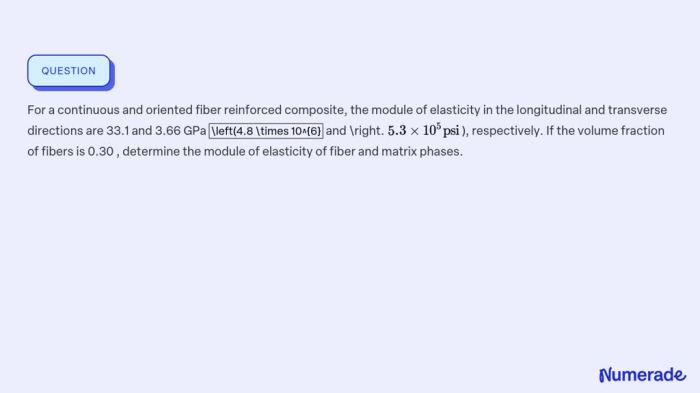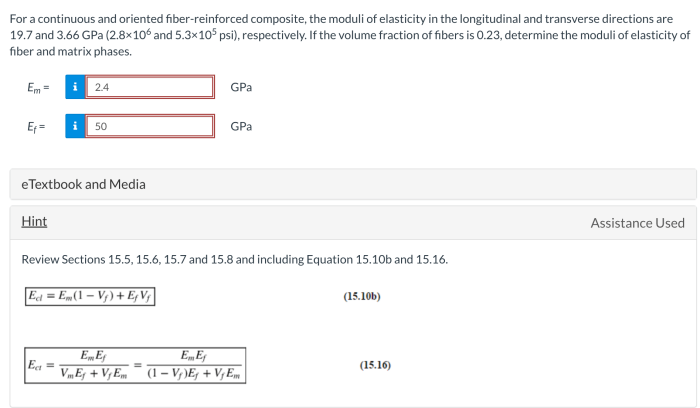For a continuous and oriented fiber-reinforced composite – Continuous and oriented fiber-reinforced composites have revolutionized various industries with their exceptional properties and diverse applications. These advanced materials combine continuous fibers, such as carbon, glass, or aramid, with a polymer matrix to create composites with unmatched strength, stiffness, and lightweight characteristics.
In this comprehensive guide, we delve into the unique properties, manufacturing techniques, design considerations, and applications of continuous and oriented fiber-reinforced composites. We explore their advantages over traditional materials, discuss the latest advancements, and highlight their potential impact on various sectors.
Continuous and Oriented Fiber-Reinforced Composites

Continuous and oriented fiber-reinforced composites (COFRCs) are advanced materials that offer exceptional mechanical properties, making them ideal for a wide range of applications. These composites consist of continuous fibers, such as carbon, glass, or aramid, embedded in a polymer matrix.
The fibers are aligned in a specific direction, resulting in a composite with high strength, stiffness, and durability.COFRCs exhibit several advantages over traditional materials, including:
- High strength-to-weight ratio: COFRCs have a very high strength-to-weight ratio, making them ideal for applications where weight reduction is crucial.
- High stiffness: COFRCs are also very stiff, providing excellent resistance to deformation under load.
- Durability: COFRCs are highly durable and resistant to wear, corrosion, and chemicals.
COFRCs are commonly used in industries such as aerospace, automotive, and sports equipment, where lightweight, high-performance materials are required.
Manufacturing Techniques

COFRCs can be manufactured using various techniques, each with its own advantages and disadvantages. The most common methods include:
- Hand lay-up: This is a simple and cost-effective method where the fibers are manually placed in a mold and the matrix is applied by hand.
- Vacuum bag molding: This method uses a vacuum to remove air from the mold, resulting in a higher-quality composite with fewer voids.
- Autoclave molding: This method uses an autoclave to apply heat and pressure to the mold, resulting in a high-performance composite with excellent mechanical properties.
The choice of manufacturing technique depends on factors such as the desired properties, the size and complexity of the part, and the cost.
Design Considerations

The design of COFRCs requires careful consideration of several factors, including:
- Fiber orientation: The orientation of the fibers has a significant impact on the mechanical properties of the composite. Fibers aligned in the direction of the applied load will provide the highest strength and stiffness.
- Fiber volume fraction: The fiber volume fraction is the ratio of the volume of fibers to the total volume of the composite. A higher fiber volume fraction will result in a stronger and stiffer composite.
- Matrix properties: The properties of the matrix, such as its strength, stiffness, and toughness, also affect the overall performance of the composite.
By optimizing these design factors, engineers can create COFRCs with tailored properties for specific applications.
Applications
COFRCs are used in a wide variety of applications, including:
- Aerospace: COFRCs are used in aircraft structures, such as wings, fuselages, and control surfaces, due to their high strength-to-weight ratio and stiffness.
- Automotive: COFRCs are used in automotive components, such as body panels, bumpers, and drive shafts, due to their lightweight and durability.
- Sports equipment: COFRCs are used in sports equipment, such as golf clubs, tennis rackets, and hockey sticks, due to their high stiffness and impact resistance.
COFRCs offer significant performance benefits over traditional materials, making them an ideal choice for applications where weight reduction, high strength, and durability are critical.
Future Trends: For A Continuous And Oriented Fiber-reinforced Composite

The future of COFRCs is promising, with advancements in materials, manufacturing techniques, and design methods.
- New materials: Researchers are developing new types of fibers with even higher strength and stiffness, which will lead to even more powerful COFRCs.
- Advanced manufacturing techniques: New manufacturing techniques, such as additive manufacturing, are being developed to produce COFRCs with complex shapes and geometries.
- Design optimization: Engineers are using computational modeling to optimize the design of COFRCs, resulting in composites with tailored properties for specific applications.
These advancements will lead to the development of COFRCs with even better performance and a wider range of applications.
FAQ Explained
What are the advantages of continuous and oriented fiber-reinforced composites?
Continuous and oriented fiber-reinforced composites offer exceptional strength-to-weight ratio, high stiffness, corrosion resistance, and tailored mechanical properties.
How are continuous and oriented fiber-reinforced composites manufactured?
These composites can be manufactured using various techniques, including hand lay-up, resin transfer molding, and pultrusion, each with its own advantages and disadvantages.
What are some common applications of continuous and oriented fiber-reinforced composites?
These composites are widely used in aerospace, automotive, sporting goods, medical devices, and construction industries due to their lightweight, durability, and design flexibility.